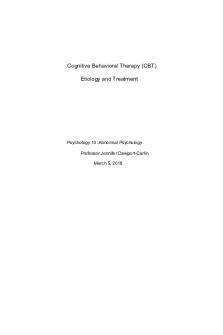Cognitive dissonance essay PDF

| Title | Cognitive dissonance essay |
|---|---|
| Course | Psychology |
| Institution | Universiteit Stellenbosch |
| Pages | 2 |
| File Size | 62.4 KB |
| File Type | |
| Total Downloads | 91 |
| Total Views | 153 |
Summary
Cognitive Dissonance Essay ...
Description
The cognitive dissonance theory, developed by Festinger, has received significant attention from many personality and social psychologists in the past. His theory has probably received more attention than any other contemporary statement with regards to human behaviour. It is therefore not surprizing that it became the most studied topic in social psychology however, this theory has also received its critiques. This theory emphasises that beliefs of the individual are the main component of an attitude and can therefore be seen as a good example of the cognitive approach used in psychology. The cognitive dissonance theory also addresses the matter of attitude-behaviours discrepancy- this is the inconsistency that may occur between an individual’s attitude and behaviour. Hogg & Vaughan describes cognitive dissonance as a hostile psychological state that causes the individual to experience tension when two cognitions are in conflict with one another. Cognitions refer to the beliefs, attitudes or the states of awareness an individual has with regards to behaviour. Festinger argued that when an individual experiences this inconsistency between cognitions he or she will be motivated to restore harmony by changing or rejecting one of the cognitions. It appears that individuals are more motivated to reduce the tension, if the amount dissonance is more significant. Studies of the electrical conductivity of skin provided evidence that dissonance causes one to feel physiological unbalanced and uneasiness. People either consciously or unconsciously avoid any exposure that might lead to dissonance because of the uneasiness it creates. Attitudes represent the organisation of those beliefs, feelings and behavioural tendencies we have towards a certain object, group, event or symbol of social importance. It is our general evaluation of social stimuli. The research of attitudes in the field of social psychology has created great interest and elaborated research has been done to determine how attitudes are connected to behaviour. It is agreed that an individual acquires attitudes through the encounters with social experiences. Attitudes offer the individual ways in which to adjust appropriately when certain social situations might arise (LaPiere, 1934). The way in which attitudes are connected to behaviour caused many debates and in the end it was concluded that attitudes seldom, if not at all predict behaviour (Hogg & Vaughan, 2008). When the literature is considered carefully it becomes apparent that attitudes and behaviour are connected in an intricate way. Even though there is a complex relationship between attitude and behaviour it is clear that attitude does influence but not predict behaviour. The cognitive dissonance theory provides an explanation for this relationship. It argues that an
individual would change or reject certain attitudes if they came into conflict with a contrasting one. This theory seems to explain that people are more motivated to change their attitude rather than the behaviour when conflict arises between them. The reason for this might be because dissonance causes discomfort and the individual seeks to restore harmony the easiest way possible and an attitude change is usually the easier option. To change behaviour such as the habit of smoking or drinking is a far more challenging process than simply changing ones attitude toward this habit. In this way behaviour can cause ones attitude to change in order to provide fast relief to the strain caused by dissonance. In conclusion it’s not surprising that Festinger’s cognitive dissonance theory received so much attention from social psychologists seeing as it provides a quite stable explanation for why behaviour can cause attitudes to change. It was found that attitude cannot actively predict behaviour and therefore does not provide an adequate explanation for the relationship that exists among attitude behaviour. The dissonance theory on the other hand concluded that individuals rather change their attitude than their behaviour when confronted with contradicting cognitions. Thus this theory in fact explains how behaviour can cause attitudes to change....
Similar Free PDFs

Cognitive dissonance essay
- 2 Pages

Essay - Social Cognitive theory
- 6 Pages

Panic essay cognitive model
- 7 Pages

COGNITIVE PSYCHOLOGY
- 591 Pages

Psychologie cognitive
- 27 Pages

Psychopathologie cognitive.
- 25 Pages
Popular Institutions
- Tinajero National High School - Annex
- Politeknik Caltex Riau
- Yokohama City University
- SGT University
- University of Al-Qadisiyah
- Divine Word College of Vigan
- Techniek College Rotterdam
- Universidade de Santiago
- Universiti Teknologi MARA Cawangan Johor Kampus Pasir Gudang
- Poltekkes Kemenkes Yogyakarta
- Baguio City National High School
- Colegio san marcos
- preparatoria uno
- Centro de Bachillerato Tecnológico Industrial y de Servicios No. 107
- Dalian Maritime University
- Quang Trung Secondary School
- Colegio Tecnológico en Informática
- Corporación Regional de Educación Superior
- Grupo CEDVA
- Dar Al Uloom University
- Centro de Estudios Preuniversitarios de la Universidad Nacional de Ingeniería
- 上智大学
- Aakash International School, Nuna Majara
- San Felipe Neri Catholic School
- Kang Chiao International School - New Taipei City
- Misamis Occidental National High School
- Institución Educativa Escuela Normal Juan Ladrilleros
- Kolehiyo ng Pantukan
- Batanes State College
- Instituto Continental
- Sekolah Menengah Kejuruan Kesehatan Kaltara (Tarakan)
- Colegio de La Inmaculada Concepcion - Cebu









